Spathiphyllum: Plant Care and Growing Guide (With Pictures)
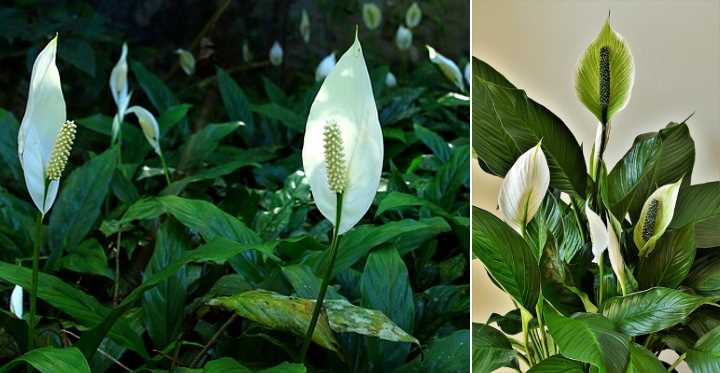
Spathiphyllum—also called peace lily—is a popular flowering houseplant with brilliant white spathe flowers. The easy-to-care-for indoor plant has large glossy green leaves and long flowering stems. Spathiphyllum plants grow in various light conditions, including low light and shade.
The plant’s ability to remove toxins from indoor air makes Spathiphyllum an excellent plant for any room in your home. Although Spathiphyllum contains toxic substances, the plants are generally safe to handle. But it’s probably best to keep Spathiphyllum plants away from pets and children in case they chew on the leaves.
How to care for Spathiphyllum: Peace lilies (Spathiphyllum) thrive in bright filtered light, well-draining fertile soil, and average room temperatures. For healthy growth, water the plant when the soil partly dries and mist the leaves regularly to increase humidity. Fertilize every month during the growing season.
The 40 species of Spathiphyllum belong to the family Araceae and are closely related to the calla lily.
Despite being called lilies, Spathiphyllum is not a real species of lily (Lilium). The plant’s botanical name comes from the beautiful white spathe-leaves.
Other common names for Spathiphyllum plants are closet plants, white sails and peace lily. Both last common names refer to the white spathe-leaf that looks like a white sail or white flag. Other species of Spathiphyllum go by names such as Mouna Loa, Madona lily, and Cupido peace lily.
This article is a comprehensive guide for Spathiphyllum care. You’ll find out how to grow indoor these flowering plants that brighten up rooms, and help clean the air.
Spathiphyllum Flowers
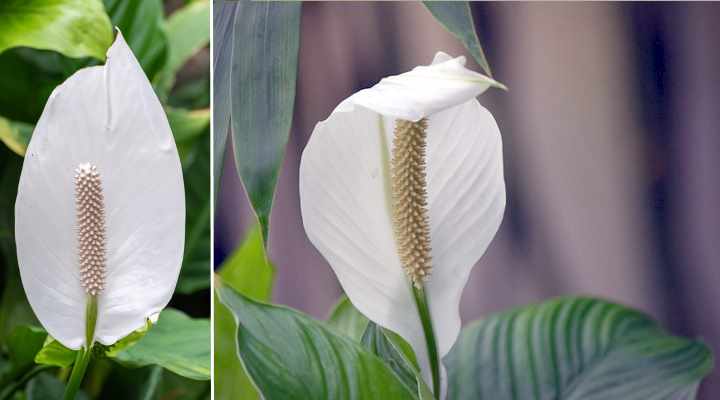
The Spathiphyllum white modified leaf is called bract or spathe and the elongated spike (spadix) is the flower
Spathiphyllum is popular due to its showy white flowers. Spathiphyllum flowers consist of a spathe—a large white or yellowish leaf-like bract. The actual flowers grow on a spadix—a type of thick stem covered with tiny flowers. Spathiphyllum flowering stems are between 4” and 12” (10 – 30 cm) long.
Most species of Spathiphyllum have brilliant snow-white spathes. Other varieties of Spathiphyllum may have yellowish or greenish spathe leaves surrounding an orange spadix. The white sheath-type flowers provide a stunning contrast against the shiny green broad leaves.
Why My Spathiphyllum Isn’t Flowering?
The most common reason why Spathiphyllum doesn’t flower is a lack of bright light. Spathiphyllum usually bloom in spring and needs bright, indirect sunlight to produce flowers. Although Spathiphyllum can survive in dark rooms, it won’t flower in places with poor lighting or constant shade.
How to Make a Spathiphyllum Plant Bloom?
Encourage a Spathiphyllum to bloom by giving it plenty of indirect light and water it appropriately. To help Spathiphyllum produce flowers, move it to a brighter location if it’s not blooming. Making sure it gets bright light can help get a non-blooming Spathiphyllum to flower repeatedly.
Most people buy Spathiphyllum plants when they’re already in bloom. So, it can be disappointing if the plant fails to flower again. Putting the Spathiphyllum pot on an east-facing windowsill or near a south- or west-facing window in the spring may encourage blooming. A healthy Spathiphyllum in ideal growing conditions should produce several flowers annually.
Spathiphyllum Care
Let’s look at the ways to care for Spathiphyllum so that it blooms regularly, its foliage is healthy, and it doesn’t get affected by pests or disease.
Spathiphyllum Light Requirements
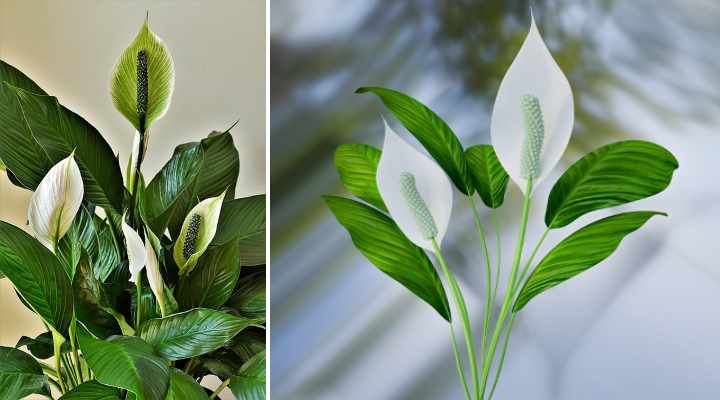
To care properly for your Spathiphyllum, place it in a bright location away from direct sunlight
Grow Spathiphyllum in bright light, but protect from direct sunlight. Getting plenty of light encourages fast growth and makes the Spathiphyllum produce flowers. The right amount of light for Spathiphyllum care should either be filtered or a mixture of light and shade.
Even though Spathiphyllum is a type of low-light plant, it rarely flowers in shaded conditions. If you want to enjoy its brilliantly white flowers and there is little natural light, use artificial light to boost the plant’s growth. However, Spathiphyllum is an excellent tropical indoor plant for offices, bedrooms, or basements due to its shiny foliage.
When growing Spathiphyllum indoors, ensure that the sun doesn’t shine on it continuously. Too much direct light causes the leaves to turn yellow and develop brown spots. Yellows leaves can also be a sign that the Spathiphyllum is severely lacking light.
Best Soil for Spathiphyllum Plants
Use a peat-based potting soil for Spathiphyllum that has excellent drainage. Or, use a cactus potting mix as a suitable growing medium. The ideal Spathiphyllum soil should keep some moisture but allow all excess water to drain. Mix peat moss, loam, and perlite to grow healthy Spathiphyllum plants in pots.
You can also use a commercial houseplant potting soil that contains organic matter. However, you should amend the soil with perlite, bark chips, or coarse horticultural sand. Organic matter such as peat moss helps to retain some moisture. And, the addition of perlite or a similar soil amendment improves drainage and aerates the potting medium.
One of the worst things for Spathiphyllum is when their roots sit in soggy, waterlogged soil. There can be a few reasons why the Spathiphyllum pot retains too much water. Some of these are:
- The Spathiphyllum has become rootbound, and water can’t drain properly.
- The potting soil is too dense and needs better aeration.
- The drainage hole on the pot’s base is blocked.
How to Water Spathiphyllum
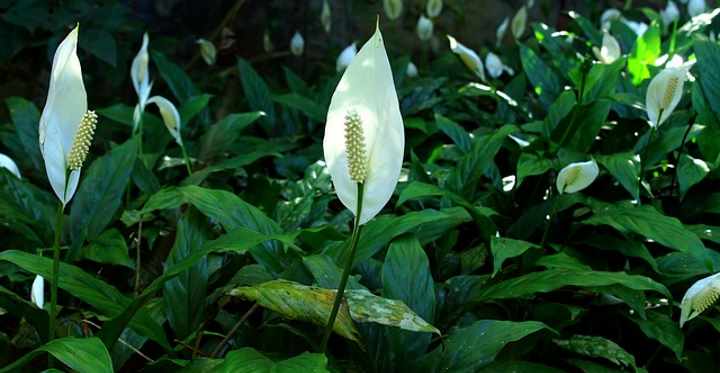
Water your Spathiphyllum plant when the top soil has dried out
Water Spathiphyllum only as often as the top layer of soil dries out. When you water the plant, you should thoroughly irrigate the potting soil. Pour in enough room-temperature filtered water or rainwater until it pours out of the drainage holes. Allow the water to drip out before putting the plant back in a bright spot.
How often you should water Spathiphyllum depends on several factors. During the growing season and hot weather, you will need to water your Spathiphyllum plant about once or twice a week. In winter, when Spathiphyllum growth slows down, water less frequently, maybe every two weeks or less.
But always let soil dryness guide the frequency when you water your Spathiphyllum plant. Please remember, that Spathiphyllum is not among the drought-tolerant houseplants. So, avoid letting the soil go completely dry.
Thorough watering provides deep hydration for the Spathiphyllum roots. The moisture allows the roots to absorb nutrients and encourages healthy growth. Don’t be afraid to drench the potting soil as long as you let it partially dry between every watering.
Related reading: A complete guide to watering houseplants.
Temperature for Growing Spathiphyllum Indoors
Spathiphyllum plants thrive in a temperature range of 65°F to 85°F (18°C – 29°C). Average indoor room temperatures are ideal for growing these tropical houseplants. Spathiphyllum can’t withstand temperatures below 55°F (12°C) or cold drafts. It’s also vital to avoid temperature extremes to prevent stressing your houseplant.
Growing outdoors, Spathiphyllum grows well in USDA zones 10b and 11. Temperatures below 65°F (18°C) during winter will affect its growth, and frost will kill the Spathiphyllum. If you plant Spathiphyllum as a backyard border plant, make sure it’s in partial shade or dappled sunlight. This prevents the plant from getting too hot in the summer and suffering from sunburn.
Spathiphyllum Humidity Requirements

Regularly mist the leaves of Spathiphyllum plant to maintain proper humidity
Spathiphyllum has above average humidity needs that mimic its native tropical environment. To humidify the plant, regularly mist the leaves daily, grow with other plants or place on a pebble tray. Try to keep air moisture levels above 50 percent to ensure healthy growth.
Regularly misting the leaves is the easiest way to humidify Spathiphyllum. Fill a spray bottle with lukewarm distilled water and spray a fine mist around its foliage. Alternatively, you can provide moisture by wiping the glossy leaves with a damp cloth. This plant cleaning will not only hydrate the leaves but remove dust too.
Spathiphyllum Growth Rate
Spathiphyllum has a moderate growth rate and will eventually reach between 18” and 24” (45 – 60 cm) in height. Light affects the growth of Spathiphyllum plants. The plant’s growth is fastest when it grows in bright, indirect light. In dark rooms or shade, the growth rate slows down considerably.
Although Spathiphyllum plants will grow in dark places, the leaves may end up drooping. You’ll also notice that a Spathiphyllum plant never blooms if there is not enough light. Under ideal conditions, your plant should grow a few inches every year.
How to Fertilize Spathiphyllum Houseplants
Apply fertilizer monthly to Spathiphyllum plants during spring and summer. Feed your plants with a balanced houseplant fertilizer to provide the appropriate nutrients. A diluted water-soluble 10-10-10 fertilizer should be enough to ensure healthy growth and regular blooming. Don’t fertilize Spathiphyllum during late fall and winter.
Regular fertilizing during the growing season boosts Spathiphyllum growth. However, a buildup of mineral salts in the potting mix can result in root burn and weak growth. To avoid this problem, flush the potting soil every two or three months between watering. All you need to do is thoroughly soak the soil by running water through it for a couple of minutes. Allow the water to drip out. Then wait until the top layer of soil is dry before watering again.
Further reading: Houseplant Fertilizers: The Best Indoor Plant Fertilizers.
Spathiphyllum Pruning Guide
Prune Spathiphyllum stems near the base of the plant. Spathiphyllum rarely needs pruning because it has natural bushy growth. The only time you need to prune this low-maintenance houseplant is to reduce its size. Also, trimming off dead or dying foliage can help improve the plant’s appearance.
After the Spathiphyllum has finished flowering, snip off the stems. A stem only produces one flower. So, when its flower fades, the stalk becomes brown and dies. Thus, pruning stems after the flowers die helps to direct energy back into the foliage growth.
Propagating Spathiphyllum
Root division is the best way to propagate a Spathiphyllum plant. To propagate the plant, remove the plant from its container, shake the dirt from the roots, then slice the root ball into two or three pieces with a sharp clean knife. Make sure there are a few healthy stems and leaves on each root piece.
The best time to propagate Spathiphyllum plants is in the spring. Spathiphyllum can be sensitive to changes, and a newly-propagated plant may wilt after repotting. Propagating in spring ensures that plant growth is vigorous, and this gives the Spathiphyllum a better chance of survival.
Repotting Spathiphyllum (Peace Lily) Plants
It’s time to repot a Spathiphyllum plant when it becomes rootbound. To repot the houseplant, remove it from its existing container. Untangle the roots and trim off any dead, brown-looking roots. Place the root ball in a new pot and fill the container with the appropriate potting mix.
If you want to encourage more growth, transfer the Spathiphyllum to a larger pot. If you’re going to limit its growth, snip off about one-third of the roots and repot in a similar-sized pot.
How do you know that a Spathiphyllum is rootbound and needs repotting? Here are a few tell-tale signs your peace lily is rootbound:
- You notice roots poking out the pot’s drainage holes.
- Water takes longer to drain from the pot because the potting medium is thick and dense.
- Water pools on the surface of the soil because it can’t drain through.
- The Spathiphyllum plant’s growth slows down even though it’s the growing season.
Is Spathiphyllum Toxic to Cats and Dogs?
Spathiphyllum plants are poisonous to cats and dogs. The ASPCA says that Spathiphyllum contains insoluble calcium oxalates. This toxic substance can cause oral irritation, drooling, burning around the mouth, vomiting, and difficulty swallowing. If you have Spathiphyllum plants at home, keep them away from cats, dogs, or other pets.
Is Spathiphyllum (Peace Lily) Toxic to Humans?
Ingesting any parts of Spathiphyllum is poisonous for humans. Researchers from North Carolina State Extension say that the plant has medium severity characteristics. Spathiphyllum can cause a burning sensation in the mouth and swelling of the lips. Other studies show that contact with the plant can cause dermatitis in people with sensitive skin.
Common Issues Growing Spathiphyllum Plants Indoors
What Pests Affect Spathiphyllum Growth?
Spathiphyllum plants are reasonably resistant to houseplant pests. However, spider mites, mealybugs, and aphids can affect plant growth. Regularly wipe the leaves to keep bugs away. If plants become infested, use an insecticidal soap or neem oil solution to eradicate the pests.
Related reading: How to get rid of houseplant pests naturally.
What Diseases Can Affect Spathiphyllum Plants?
Root rot caused by over-watering or poor drainage can cause Spathiphyllum disease. If you notice leaves become brown and wilting, your houseplant may have diseased roots. To help revive a dying Spathiphyllum, repot the plant in fresh, sterile potting soil. Also, remove all signs of dead or decaying roots to help bring your plant back to life.
Brown Tips on Spathiphyllum Leaves
The most common reason for brown tips on Spathiphyllum is over-watering or under-watering. However, a lack of humidity or a buildup of fertilizer salts can also cause Spathiphyllum leaves to turn brown. Prune unsightly brown leaves and adjust your watering schedule or increase humidity.
Why Spathiphyllum Leaves are Drooping
Watering issues—either too much or too little—cause Spathiphyllum leaves to droop. What if you are watering your plant correctly, and Spathiphyllum leaves are still drooping? Cold drafts or sudden temperature changes can cause all types of Spathiphyllum plants to wilt and make the leaves look sagging.
Is Spathiphyllum an Air-Cleaning Houseplant?
Spathiphyllum cleans household air by removing toxins from it. According to a NASA study on air-cleaning houseplants, Spathiphyllum can remove harmful airborne chemicals such as benzene, formaldehyde, and trichloroethylene. A combination of other air-filtering houseplants such as English ivy, golden pothos, Dracaena ‘Warneckii,’ and Sansevieria can help improve indoor air quality.
Varieties of Spathiphyllum
Here are some of the most common varieties of Spathiphyllum to grow indoors:
Spathiphyllum wallisii (Peace lily)
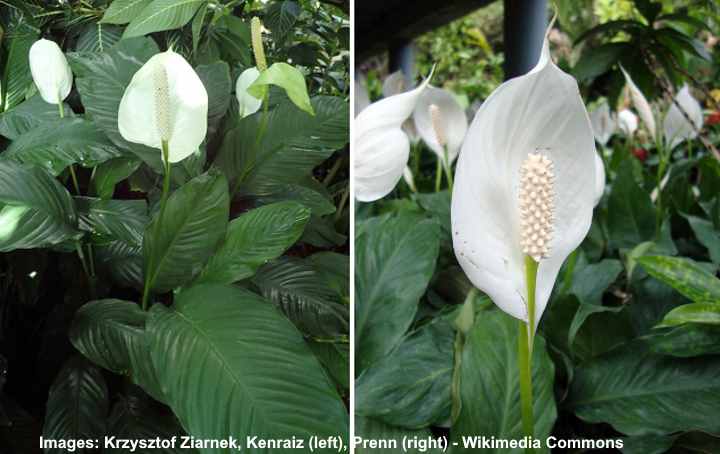
Spathiphyllum wallisii is the most common variety in the species. Also called peace lily, Madonna lily, spathe flower, or white sails, the popular houseplant has creamy-white flowers on the end of a long stem. The spathe turns a whitish-green as the plant matures.
Spathiphyllum cochlearispathum (Cupido peace lily)
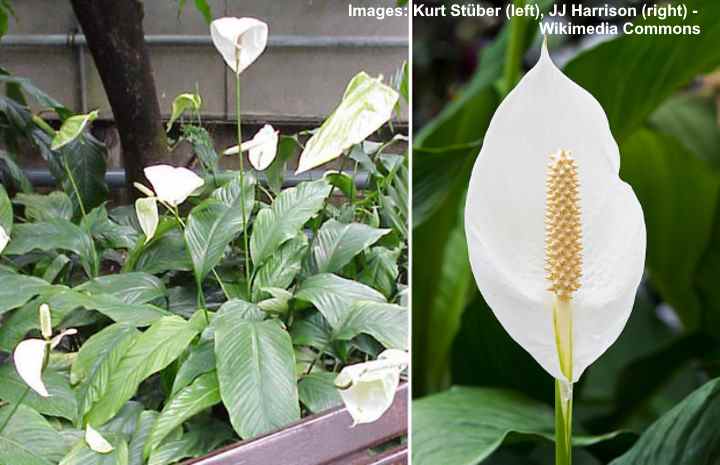
The species Spathiphyllum cochlearispathum also goes by the name peace lily. The evergreen leafy plant has broad, glossy green leaves and brilliant white flowers that bloom regularly throughout the year.
Spathiphyllum floribundum (Snowflower)
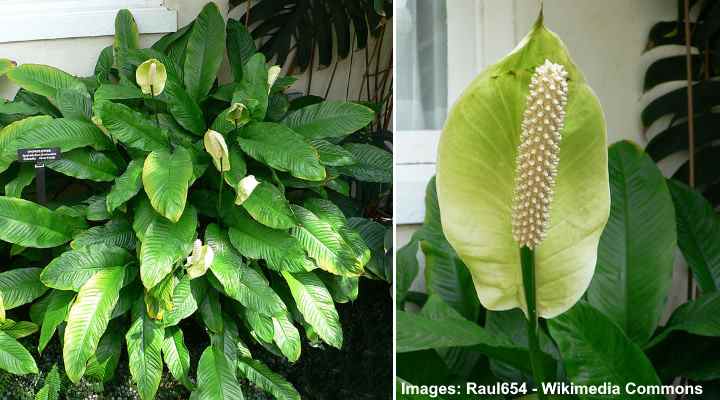
Pictures of the Spathiphyllum floribundum show that the large spathe is lime-green to yellowish-green color. The Spathiphyllum flowers are on a thick, fleshy creamy white spadix.
Spathiphyllum montanum
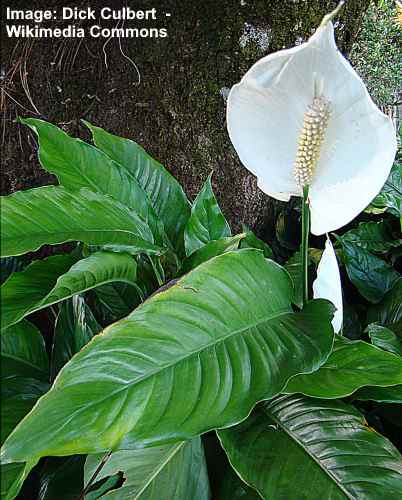
Another species of peace lily is the Spathiphyllum montanum. The dark green shiny leaves contrasting with a pure white spathe helps to identify this houseplant.
Spathiphyllum ortgiesii Regel
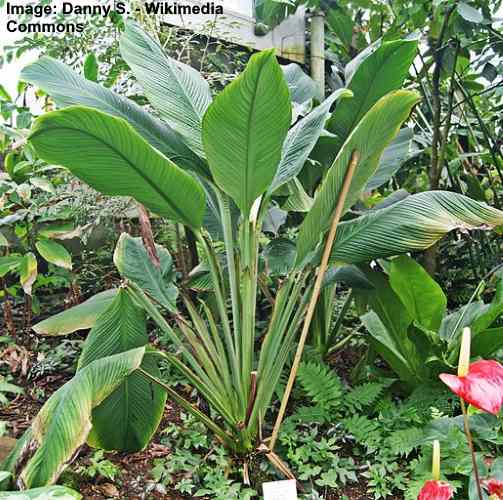
Native to Mexico, the Spathiphyllum ortgiesii produces a sizeable white spathe that is more oval-shaped than other species of Spathiphyllum flowers.
Spathiphyllum silvicola
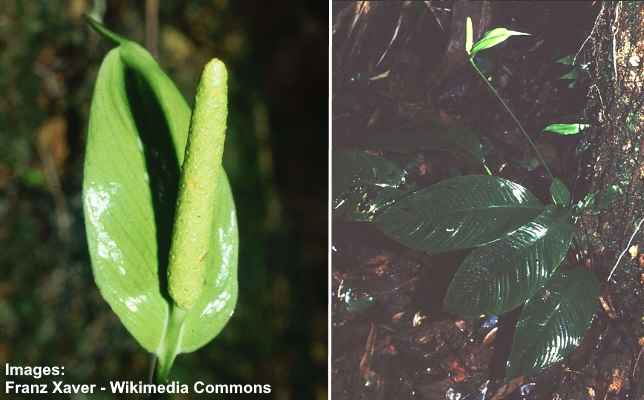
The Spathiphyllum silvicola is native to Colombia and Costa Rica. Like all species of Spathiphyllum, the flowers consist of a whitish-green spathe and yellowish spadix.
Related articles:
- 10 Best Air Filtering House Plants, According to NASA
- 10 Plants that Attract Good Luck, Prosperity and Fortune
- The Most Popular Flowers in The World
